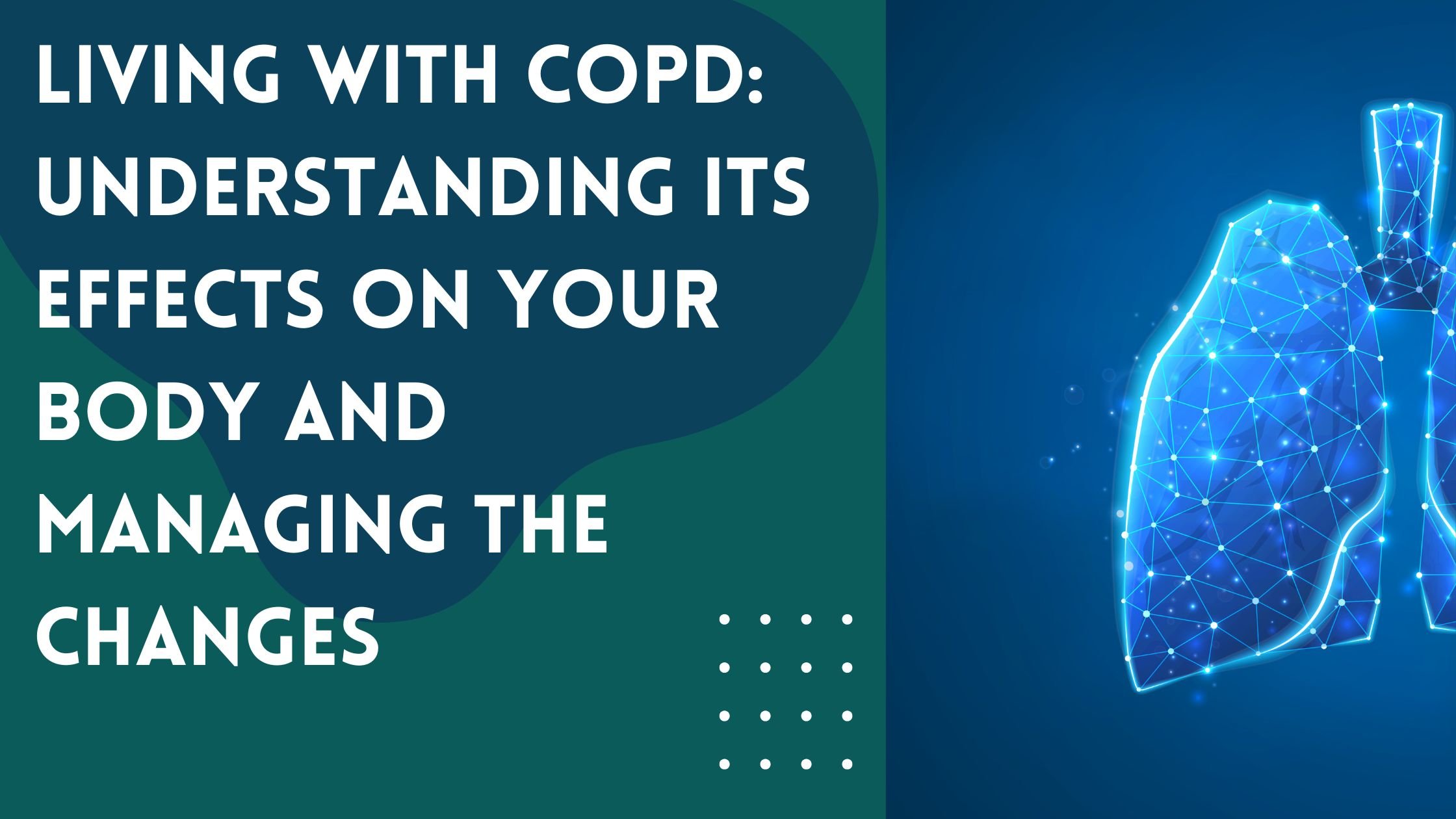
Chronic Obstructive Pulmonary Disease (COPD) is a chronic respiratory condition characterized by progressive airflow limitation. It is a complex and debilitating condition that affects millions of individuals worldwide, with its prevalence expected to rise in the coming years.
COPD encompasses various conditions, including chronic bronchitis and emphysema, and is primarily caused by long-term exposure to harmful gases or particles, most commonly from smoking.
While the primary impact of COPD is on the lungs, it is essential to recognize that this condition can have far-reaching effects on different aspects of the body. Understanding these effects is crucial for individuals diagnosed with COPD, as it allows them to proactively manage the changes they experience and improve their overall well-being.
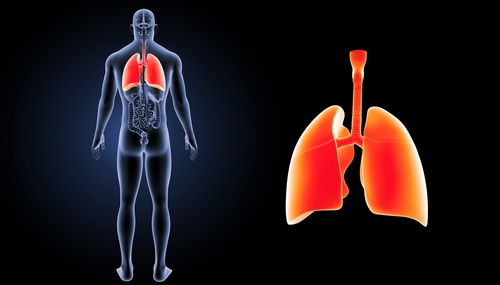
In this blog, we will delve into the multifaceted ways in which COPD can affect the body. We will explore the impact of COPD on weight, exercise capabilities, lung capacity, skin health, and mental well-being.
By examining these different areas, we can gain insights into the challenges faced by individuals with COPD and provide practical strategies for managing these changes effectively.
Each section will not only explore the physical effects but will also provide actionable tips and suggestions to better manage the associated challenges. By empowering individuals with COPD to take control of their health, we aim to enhance their quality of life and promote a sense of well-being despite the challenges posed by this chronic condition.

It is important to note that COPD affects each person differently, and individual experiences may vary. Consulting with healthcare professionals, such as pulmonologists, registered dietitians, and mental health specialists, is crucial for personalized guidance and support throughout the journey of living with COPD.
Now, let us delve into the specific areas affected by COPD and explore how they can be managed effectively to promote a healthier and more fulfilling life.
Weight Management with COPD

Gaining weight
Weight gain is a common concern for individuals diagnosed with COPD. Several factors contribute to weight gain in COPD patients, and understanding these factors can help individuals better manage their weight and overall health.
One primary reason for weight gain in COPD is the decrease in physical activity levels. COPD symptoms, such as shortness of breath and fatigue, can make it challenging for individuals to engage in regular exercise or physical activities. As a result, their overall energy expenditure decreases, leading to weight gain over time.
Furthermore, certain medications prescribed to manage COPD symptoms, such as corticosteroids, can also contribute to weight gain. Steroids are known to increase appetite and promote fluid retention, both of which can lead to weight gain. It is important to strike a balance between managing COPD symptoms with medications while being mindful of their potential side effects.

Additionally, individuals with COPD may face difficulties in maintaining a healthy diet. Breathlessness and fatigue can make eating and meal preparation more challenging. In some cases, individuals may opt for convenience foods that are often high in calories, unhealthy fats, and sodium. These dietary choices, coupled with decreased physical activity, can further contribute to weight gain.
Weight gain in COPD can have significant implications for overall health and disease management. Excess weight can strain the respiratory system, making breathing even more difficult. It can also increase the risk of other comorbidities, such as cardiovascular diseases and diabetes, which can further worsen the impact of COPD.
However, it is important to note that weight gain is not inevitable for all individuals with COPD. With appropriate lifestyle modifications, including dietary adjustments and regular physical activity within individual limitations, it is possible to manage weight effectively and maintain a healthy body composition.
Weight Gain Overveiw:
- The Impact of Inactivity: Due to shortness of breath and fatigue, individuals with COPD may become less active, leading to weight gain.
- Medications and Steroids: Some medications used to manage COPD symptoms can contribute to weight gain.
- Strategies for Weight Management: Emphasize a balanced diet, portion control, and regular physical activity within your limitations.
- Consult a Registered Dietitian: Seeking professional guidance can help develop a personalized meal plan that suits your nutritional needs while managing weight.
Losing weight

Weight loss is another common issue observed in individuals with COPD. Several factors contribute to weight loss in COPD patients, and understanding these factors is crucial for effectively managing nutritional needs and overall health.
One primary reason for weight loss in COPD is the increased energy expenditure associated with the condition. The effort required to breathe due to narrowed airways and reduced lung function can significantly increase the body's energy demands.
As a result, individuals with COPD may experience a higher metabolic rate, leading to increased calorie expenditure even at rest. This increased energy expenditure, combined with reduced appetite, can result in weight loss over time.
Breathlessness during physical activities and meals can make it challenging for individuals with COPD to consume enough calories to meet their energy needs. The sensation of breathlessness may reduce appetite or create a sense of fullness, making it difficult to consume adequate amounts of food.
Additionally, fatigue and the overall burden of managing COPD symptoms can contribute to decreased interest in eating and meal preparation.
Certain medications used to manage COPD symptoms can also play a role in weight loss. For example, bronchodilators and corticosteroids may suppress appetite or cause gastrointestinal side effects, leading to reduced food intake and subsequent weight loss.
Weight loss in COPD can have significant implications for overall health and disease management. It can lead to muscle wasting and weakness, compromising respiratory muscles and further exacerbating breathing difficulties. Additionally, weight loss can weaken the immune system, making individuals more susceptible to infections and impairing their ability to recover from exacerbations.
Addressing weight loss in COPD involves a comprehensive approach that includes optimizing nutritional intake, managing symptoms, and engaging in appropriate physical activity. In the next section, we will explore strategies for weight maintenance and provide practical dietary and lifestyle recommendations to help individuals with COPD achieve and maintain a healthy weight while effectively managing their respiratory condition.
Weight Loss overview:
- Increased Energy Expenditure: COPD can cause an increase in energy expenditure due to labored breathing and the body's effort to breathe efficiently.
- Loss of Appetite: Breathing difficulties can make eating challenging, leading to a decreased appetite.
- Strategies for Weight Maintenance: Frequent, smaller meals; nutrient-dense foods; and breathing techniques can help optimize calorie intake while minimizing exertion.
In the next section, we will explore how patients with COPD are limited in their exercise, while managing their respiratory condition.
Exercise Capabilities and COPD
Exercise becomes harder for individuals with COPD due to several factors related to the condition. The primary factor is the progressive airflow limitation caused by COPD, which impairs the ability of the lungs to efficiently exchange oxygen and remove carbon dioxide.
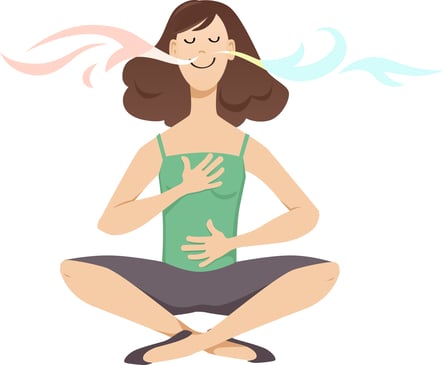
As a result, individuals experience shortness of breath, reduced lung capacity, and decreased oxygen supply to the muscles during physical exertion.
The reduced lung capacity makes it difficult for individuals with COPD to take in deep breaths and fully exhale, leading to a feeling of breathlessness and fatigue with even mild exercise. The respiratory muscles also become weaker over time, further contributing to exercise intolerance.
However, despite these challenges, regular exercise is highly beneficial for individuals with COPD. It helps improve overall cardiovascular fitness, strengthens muscles, and enhances respiratory function. Exercise can also boost energy levels, reduce breathlessness during daily activities, and improve quality of life.

To overcome the challenges of exercise intolerance, many individuals with COPD utilize portable oxygen concentrators (POCs) like the ARYA Airvito Max, provided by LPT Medical, to support their exercise goals.
These POCs deliver a continuous flow of concentrated oxygen directly to the individual, supplementing the reduced oxygen levels in their blood and improving their exercise capacity.
The ARYA Airvito Max is a lightweight and compact POC that offers convenience and freedom of movement during exercise. It provides a reliable oxygen supply, allowing individuals with COPD to engage in physical activities with less breathlessness and fatigue. By delivering oxygen directly, POCs help improve oxygenation, increase exercise tolerance, and enhance overall performance.
Using a portable oxygen concentrator like the ARYA Airvito Max during exercise enables individuals with COPD to exercise for longer durations and at higher intensities. It helps maintain oxygen saturation levels, preventing the onset of significant desaturation during physical exertion. This promotes a more effective workout, allowing individuals to reach their exercise goals and experience the associated health benefits.
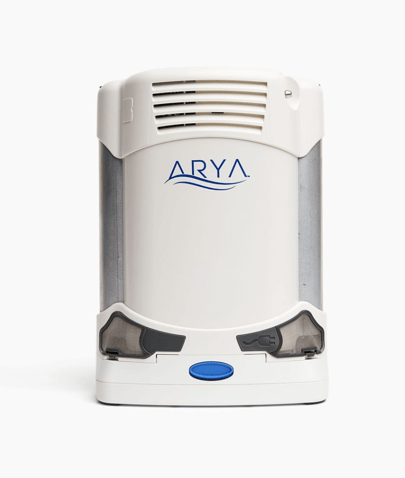
Moreover, the ARYA Airvito Max offers portability and long-lasting battery life, making it suitable for various exercise settings, whether indoors or outdoors. Its user-friendly design and adjustable settings ensure optimal oxygen delivery based on individual needs, supporting personalized exercise routines.
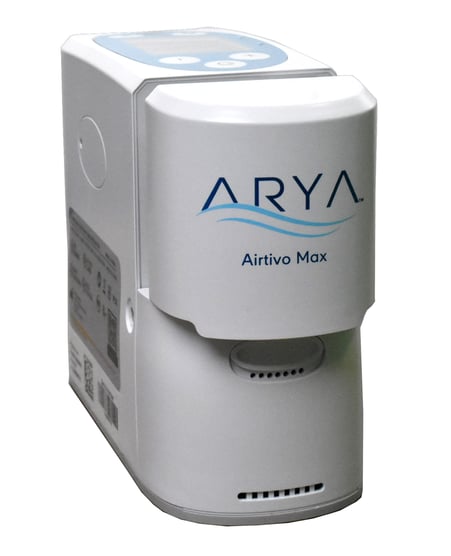
Incorporating a portable oxygen concentrator like the ARYA Airvito Max into an exercise regimen for individuals with COPD can be a game-changer. It provides the necessary oxygen support, enhances exercise capacity, and empowers individuals to engage in physical activities with greater confidence, ultimately leading to improved overall fitness and well-being.
- Exercise Limitations:
- Reduced Endurance: COPD restricts airflow, leading to increased breathlessness and reduced exercise capacity.
- Muscle Weakness: Decreased physical activity can result in muscle loss and weakness.
- Pulmonary Rehabilitation: Participating in pulmonary rehabilitation programs can help improve exercise tolerance, muscle strength, and overall quality of life.
- Strategies for Exercise:
- Gradual Progression: Start with low-intensity exercises and gradually increase duration and intensity.
- Breathing Techniques: Employ techniques like pursed-lip breathing and diaphragmatic breathing to enhance breathing efficiency during exercise.
- Tailored Exercise Plans: Consult with a healthcare professional to develop a personalized exercise plan that considers your specific needs and limitations.
Common Dietary Restrictions for COPD
Individuals with COPD need to watch their diet and be mindful of what they eat due to several reasons related to their respiratory condition. Proper nutrition plays a crucial role in managing COPD symptoms, maintaining a healthy weight, and supporting overall well-being. By being aware of certain foods that can cause bloating, restrict breathing, or have other negative impacts, individuals with COPD can make informed dietary choices to optimize their health.
Bloating and Gas

Certain foods can contribute to bloating and increased gas production, which can cause discomfort and impact breathing for individuals with COPD.
Some common culprits include:
- Carbonated beverages
- Fizzy drinks can lead to bloating and increased gas in the stomach.
- Cruciferous vegetables: Vegetables like broccoli, cabbage, and cauliflower are known to produce gas during digestion.
- Legumes: Beans, lentils, and chickpeas contain complex carbohydrates that can cause gas and bloating.
To manage bloating and gas, individuals with COPD can try:
- Opting for non-carbonated beverages or drinking them in moderation.
- Cooking cruciferous vegetables thoroughly to make them easier to digest.
- Gradually increasing intake of legumes to allow the body to adapt to the increased fiber content.
- Sodium and Fluid Retention:
- Excessive sodium intake can contribute to fluid retention, which can worsen swelling and breathing difficulties in individuals with COPD. It is important to be mindful of foods high in sodium, including:
- Processed and packaged foods: These often contain high levels of sodium for preservation purposes.
- Canned soups and broths: These commonly have high sodium content.
To manage sodium intake and fluid retention, individuals with COPD can:
- Read food labels and choose low-sodium or sodium-free alternatives.
- Cook meals at home using fresh ingredients, allowing for better control over sodium content.
- Use herbs, spices, and other sodium-free seasonings to enhance the flavor of meals.
Excessive Fat and Weight Management:
- Maintaining a healthy weight is important for individuals with COPD to reduce the strain on their respiratory system. Foods high in unhealthy fats can contribute to weight gain and worsen COPD symptoms. Such foods include:
- Fried and fatty foods: These are typically high in unhealthy saturated and trans fats.
- Processed snacks and desserts: These often contain high levels of unhealthy fats and added sugars.
To promote weight management and overall health, individuals with COPD can try these methods:
- Focus on consuming healthy fats from sources like avocados, nuts, and seeds.
- Choose lean protein sources such as poultry, fish, and legumes.
- Emphasize a balanced diet rich in fruits, vegetables, whole grains, and lean proteins.
Every individual with COPD may have specific dietary sensitivities or triggers that can worsen their symptoms. It is important to identify these triggers.
Common triggers include:
- Allergens
- Some individuals may be sensitive to specific allergens such as pollen, dust mites, or certain foods.
- Acidic or spicy foods:
- These can cause acid reflux or heartburn, exacerbating breathing difficulties.
To identify and manage individual sensitivities, individuals with COPD can:
- Keep a food diary to track symptoms and identify potential triggers.
- Consult with a registered dietitian or healthcare professional to develop a personalized meal plan.
- Being mindful of diet and making informed food choices can significantly benefit individuals with COPD.
By avoiding foods that can cause bloating, restrict breathing, or have other negative impacts, individuals can better manage their symptoms, maintain a healthy weight, and support their overall respiratory health.
- Sodium Restriction:
- Fluid Retention: COPD can cause fluid retention, making it necessary to limit sodium intake.
- Reading Food Labels: Be mindful of high-sodium foods and opt for low-sodium alternatives.
- Flavor Enhancement: Use herbs, spices, and other sodium-free seasonings to add flavor to meals.
- Fluid Management:
- Balancing Fluid Intake: COPD-related medications and other factors may require monitoring fluid intake.
- Hydration Tips: Sip fluids throughout the day, choose hydrating foods, and consult a healthcare professional for specific guidelines.
Decrease in Lung Capacity and COPD
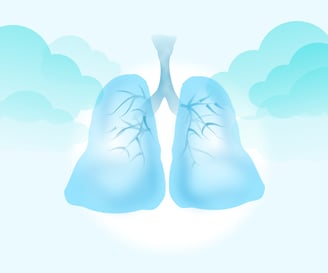
Most common of all of these changes, is probably how lung capacity starts to decrease. One of the defining characteristics of COPD is the progressive decline in lung function and capacity over time. This decrease in lung capacity is primarily attributed to the damage and inflammation that occurs in the airways and lung tissue due to long-term exposure to irritants, most commonly cigarette smoke.
The process of lung capacity reduction in COPD can be attributed to several factors:
- Chronic Inflammation: The continuous exposure to irritants triggers an inflammatory response in the airways and lung tissue. This inflammation leads to structural changes, narrowing of the airways, and the formation of excess mucus. As a result, the airways become obstructed, making it difficult for air to flow in and out of the lungs efficiently.
- Air Trapping: As COPD progresses, individuals experience difficulty exhaling fully. This is known as air trapping, where some air becomes trapped in the lungs, reducing the available space for fresh air to enter during inhalation. The trapped air leads to hyperinflation of the lungs, causing them to become overinflated and less elastic over time.
- Destruction of Lung Tissue: In emphysema, a subtype of COPD, the walls of the air sacs in the lungs (alveoli) become damaged and lose their elasticity. The destruction of these delicate structures reduces the surface area available for oxygen exchange, impairing the overall lung function and capacity.
The feeling of decreased lung capacity in individuals with COPD can vary depending on the severity of the condition. Initially, individuals may notice a mild shortness of breath during physical exertion. As COPD progresses, breathlessness can occur even with minimal activity or at rest.
The sensation of breathlessness can be distressing, leading to feelings of anxiety, fatigue, and reduced exercise tolerance. Simple tasks like climbing stairs or carrying groceries may become increasingly challenging. The decreased lung capacity can also result in a persistent cough, wheezing, and increased susceptibility to respiratory infections.
It is important for COPD patients to understand that the progressive decrease in lung capacity is a hallmark of the disease and a natural consequence of the underlying lung damage. While this decline cannot be reversed, early diagnosis and appropriate management can slow down the progression of the disease and alleviate symptoms.
COPD patients can expect that their lung capacity will gradually decrease over time. However, by adopting proactive measures, they can effectively manage their condition and maintain an optimal quality of life. Pulmonary rehabilitation programs, prescribed medications, and lifestyle modifications, such as quitting smoking, can help manage symptoms, improve lung function, and enhance overall well-being.
Regular exercise, within individual limitations, is also beneficial as it can help improve cardiovascular fitness, strengthen respiratory muscles, and enhance lung function. Breathing techniques, such as pursed lip breathing and diaphragmatic breathing, can assist in maximizing the utilization of available lung capacity and reducing breathlessness.
It is important for individuals with COPD to work closely with their healthcare team to monitor lung function regularly, adjust treatment plans as needed, and receive ongoing support and education regarding self-management strategies.
While the decrease in lung capacity is a significant challenge for individuals with COPD, with appropriate management and support, they can adapt to these changes, maintain an active lifestyle, and lead fulfilling lives.
- Understanding Lung Capacity:
- Lung Function Tests: Spirometry tests measure lung capacity and can aid in COPD diagnosis and monitoring.
- Forced Expiratory Volume (FEV1): FEV1 measures the amount of air forcefully exhaled in one second.
- Coping Strategies: Engage in breathing exercises, utilize bronchodilators, and avoid triggers to optimize lung function.
- Managing Shortness of Breath:
- Pursed-Lip Breathing: Slow, controlled exhalation through pursed lips can help reduce breathlessness.
- Positioning Techniques: Adopting a relaxed, upright posture can facilitate easier breathing.
- Energy Conservation: Prioritize activities, delegate tasks, and use energy-saving techniques to minimize the strain on your lungs and conserve energy.
COPD and Skin Health
ti may come as a surprise, but COP has has profound impacts on people's skin.
- Dry Skin:
- Dehydration: COPD-related medications and increased fluid loss through breathing can contribute to dry skin.
- Moisturizing Routine: Use gentle, fragrance-free moisturizers to hydrate and protect the skin.
- Avoid Hot Water: Hot showers or baths can further dry out the skin, so opt for lukewarm water instead.
- Nail and Hair Changes:
- Brittle Nails: Oxygen deprivation can cause nails to become weak and brittle.
- Hair Loss: Certain medications used to manage COPD symptoms may lead to hair loss.
- Proper Nail and Hair Care: Keep nails trimmed and moisturized, and consult a healthcare professional regarding hair loss concerns.
COPD and Mental Well-being
- Anxiety and Depression:
- Breathlessness and Panic: COPD can cause breathlessness, leading to anxiety or panic attacks.
- Social Isolation: The limitations imposed by COPD can contribute to feelings of loneliness and depression.
- Support Networks: Engage with support groups, counseling services, or therapy to address psychological challenges associated with COPD.
- Cognitive Function:
- Cognitive Impairment: COPD has been linked to mild cognitive impairment and an increased risk of developing dementia.
- Mental Stimulation: Engage in activities that stimulate the brain, such as puzzles, reading, or learning new skills.
- Stay Physically Active: Regular physical activity has been shown to improve cognitive function and reduce the risk of cognitive decline.
Managing Changes and Enhancing Well-being
- Medication Adherence:
- Follow Prescribed Regimens: Take medications as directed by your healthcare provider to manage symptoms and prevent exacerbations.
- Discuss Side Effects: Communicate any side effects or concerns with your healthcare provider to explore alternative options.
- Supportive Lifestyle Modifications:
- Breathing Techniques: Practice breathing exercises regularly to optimize lung function and manage breathlessness.
- Pulmonary Rehabilitation: Consider participating in pulmonary rehabilitation programs to improve overall lung health and quality of life.
- Emotional Support: Seek emotional support from friends, family, support groups, or counseling services to cope with the emotional impact of COPD.
Conclusion
Living with COPD can bring about various changes in your body, affecting weight, exercise capabilities, lung capacity, skin health, and mental well-being. However, with proper management strategies and lifestyle modifications, you can effectively navigate these changes and enhance your overall well-being. Remember to consult with your healthcare provider, registered dietitian, or other relevant professionals to develop a personalized approach to managing COPD and its effects on your body. With proper care and support, you can lead a fulfilling life despite COPD.



